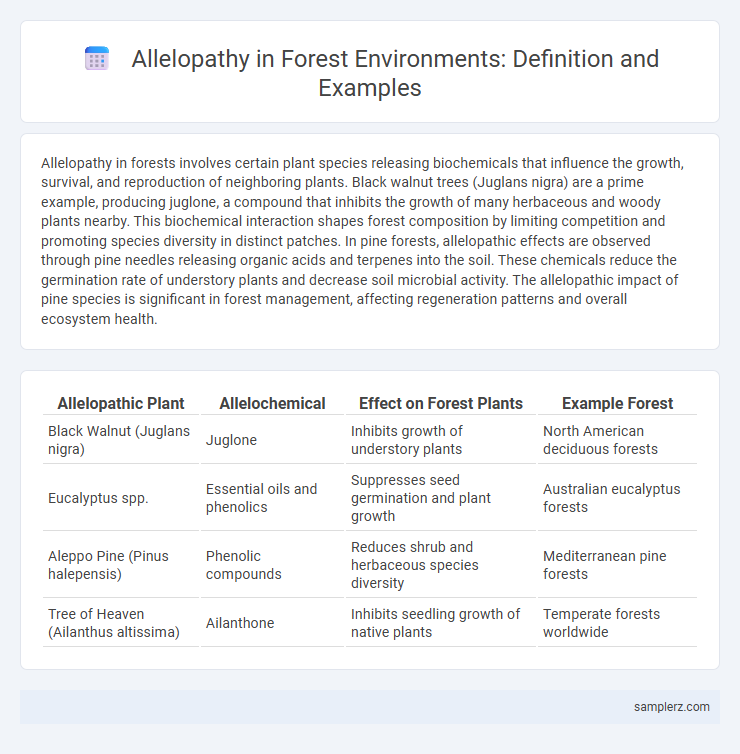Allelopathy in forests involves certain plant species releasing biochemicals that influence the growth, survival, and reproduction of neighboring plants. Black walnut trees (Juglans nigra) are a prime example, producing juglone, a compound that inhibits the growth of many herbaceous and woody plants nearby. This biochemical interaction shapes forest composition by limiting competition and promoting species diversity in distinct patches. In pine forests, allelopathic effects are observed through pine needles releasing organic acids and terpenes into the soil. These chemicals reduce the germination rate of understory plants and decrease soil microbial activity. The allelopathic impact of pine species is significant in forest management, affecting regeneration patterns and overall ecosystem health.
Table of Comparison
| Allelopathic Plant | Allelochemical | Effect on Forest Plants | Example Forest |
|---|---|---|---|
| Black Walnut (Juglans nigra) | Juglone | Inhibits growth of understory plants | North American deciduous forests |
| Eucalyptus spp. | Essential oils and phenolics | Suppresses seed germination and plant growth | Australian eucalyptus forests |
| Aleppo Pine (Pinus halepensis) | Phenolic compounds | Reduces shrub and herbaceous species diversity | Mediterranean pine forests |
| Tree of Heaven (Ailanthus altissima) | Ailanthone | Inhibits seedling growth of native plants | Temperate forests worldwide |
Introduction to Allelopathy in Forest Ecosystems
Allelopathy in forest ecosystems involves the release of biochemical substances by certain plants, such as black walnut (Juglans nigra) and eucalyptus species, which inhibit the growth of neighboring vegetation. These allelochemicals impact seed germination, root development, and nutrient uptake, shaping plant community dynamics and biodiversity. Understanding these interactions aids in forest management and conservation by revealing natural mechanisms of species competition and coexistence.
Classic Examples of Allelopathic Forest Species
Black walnut (Juglans nigra) is a classic example of an allelopathic forest species, releasing juglone from its roots and fallen leaves to inhibit the growth of surrounding plants. Eucalyptus trees produce cineole compounds that suppress undergrowth, reducing competition for nutrients and water. Pine species, such as Pinus sylvestris, emit acidic compounds from their needles, creating a soil environment unfavorable for many herbaceous plants.
Black Walnut (Juglans nigra) and Its Allelopathic Effects
Black Walnut (Juglans nigra) releases juglone, a natural allelochemical that inhibits the growth of nearby plant species, creating a competitive advantage in forest ecosystems. Juglone affects seed germination and root development of understory plants such as maples and pines, reducing biodiversity around Black Walnut stands. Research on juglone's soil persistence and impact highlights the species' significant role in shaping plant community dynamics through allelopathy.
Eucalyptus Trees and Their Impact on Understory Vegetation
Eucalyptus trees release allelopathic chemicals such as cineole from their leaves and roots, inhibiting the growth of understory vegetation and reducing plant biodiversity in forests. These compounds alter soil nutrient availability and microbial communities, creating a suppressive environment for seed germination and seedling development of competing plant species. The dominance of Eucalyptus allelopathy can lead to simplified forest structure and affect ecosystem functions like nutrient cycling and habitat provision.
Pine Needles: Chemical Inhibition in Coniferous Forests
Pine needles release allelopathic chemicals such as terpenes and phenolic compounds that inhibit the germination and growth of understory vegetation in coniferous forests. This chemical inhibition reduces competition for nutrients, water, and sunlight, promoting pine dominance in forest ecosystems. Studies show that the accumulation of pine needle litter significantly alters soil pH and microbial communities, further affecting plant biodiversity.
Allelopathy between American Beech and Companion Plants
Allelopathy in forests involves the chemical inhibition of one plant species by another through the release of biochemicals into the environment. The American Beech (Fagus grandifolia) releases allelochemicals from its leaf litter and roots that suppress the growth of certain companion plants such as understory shrubs and herbaceous species. These allelopathic interactions influence plant community composition, nutrient cycling, and forest regeneration dynamics in temperate deciduous forests.
Invasive Species: Ailanthus altissima and Native Forest Suppression
Ailanthus altissima, commonly known as the tree of heaven, exhibits strong allelopathic effects in native forests by releasing chemical compounds that suppress the growth of surrounding vegetation. This invasive species disrupts local ecosystems by inhibiting seed germination and reducing biodiversity, leading to a decline in native tree regeneration. Its allelochemicals, such as ailanthone, create an unfavorable environment for native plants, facilitating its spread and dominance in forested areas.
Allelopathic Interactions in Tropical Rainforests
Allelopathic interactions in tropical rainforests involve plants such as the black walnut (Juglans nigra) and certain species of Eucalyptus, which release biochemical compounds into the soil to inhibit the growth of competing vegetation. These allelochemicals affect seed germination and root development of neighboring plants, influencing forest composition and nutrient cycling. Understanding these natural chemical dynamics is crucial for preserving biodiversity and managing sustainable rainforest ecosystems.
Ecological Implications of Allelopathy on Forest Biodiversity
Allelopathy in forests, such as the release of juglone by black walnut trees (Juglans nigra), significantly influences species composition by inhibiting the growth of competing vegetation. This biochemical interaction alters understory plant diversity and spatial distribution, thereby shaping forest community structure and ecosystem dynamics. Understanding allelopathic effects is crucial for forest management and conservation strategies aimed at maintaining biodiversity and ecological balance.
Management Strategies Addressing Allelopathy in Forest Restoration
Management strategies addressing allelopathy in forest restoration involve careful selection of tree species that exhibit low allelopathic effects, such as pine (Pinus spp.) and oak (Quercus spp.), to minimize growth inhibition of neighboring plants. Implementing soil remediation techniques, including biochar application and activated carbon amendments, helps to adsorb and neutralize allelochemicals, promoting healthier soil microbial communities. Controlled planting patterns and timely removal of allelopathic litter reduce the accumulation of inhibitory compounds, facilitating the establishment of diverse and resilient forest ecosystems.

example of allelopathy in forest Infographic
 samplerz.com
samplerz.com